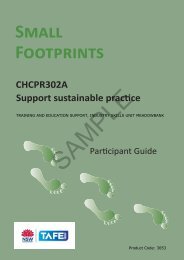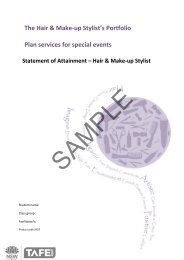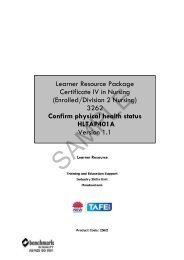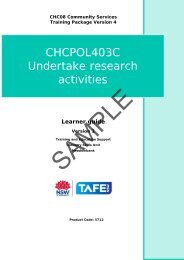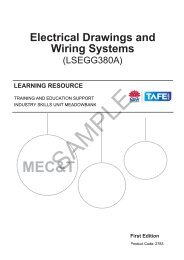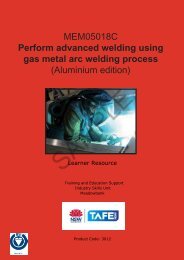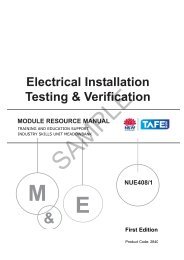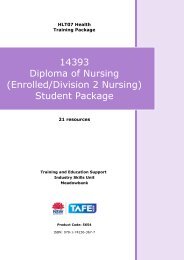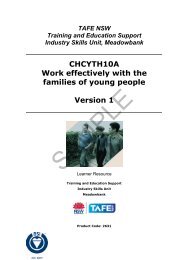HLTEN505A - vetres
HLTEN505A - vetres
HLTEN505A - vetres
You also want an ePaper? Increase the reach of your titles
YUMPU automatically turns print PDFs into web optimized ePapers that Google loves.
HLT07 Health<br />
Training Package<br />
<strong>HLTEN505A</strong><br />
Contribute to the<br />
complex nursing care of<br />
clients<br />
Learner resource<br />
Version 2<br />
SAMPLE<br />
Training and Education Support<br />
Industry Skills Unit<br />
Meadowbank
<strong>HLTEN505A</strong> Contribute to the complex nursing care of clients<br />
Acknowledgments<br />
The TAFE NSW Training and Education Support Industry Skills Unit, Meadowbank<br />
would like to acknowledge the support and assistance of the following people in the<br />
production of this learner resource guide:<br />
Writers:<br />
Rhonda Albani Kathryn Austin Dorothy Barnes Kylie Brennan<br />
Sherryl Dismorr Elaine Foss Beth Rutherford Sue Spozetta<br />
TAFE NSW<br />
Reviewers/Editor:<br />
Liz Bougaardt<br />
Amanda Culver<br />
Wendy Howe<br />
TAFE NSW<br />
Project Manager:<br />
Amanda Culver<br />
Project Coordinator<br />
Training and Education Support, Industry Skills Unit, Meadowbank<br />
TAFE NSW<br />
Acknowledgements are also given to all TAFE NSW teachers of the Enrolled Nurse<br />
Education Program.<br />
Enquiries<br />
Enquiries about this and other publications can be made to:<br />
Training and Education Support Industry Skills Unit, Meadowbank<br />
Meadowbank TAFE<br />
Level 3, Building J,<br />
See Street,<br />
MEADOWBANK NSW 2114<br />
SAMPLE<br />
Tel: 02-9942 3200 Fax: 02-9942 3257<br />
© The State of New South Wales, Department of Education and<br />
Training, TAFE NSW, Training and Education Support Industry Skills<br />
Unit, Meadowbank, 2010.<br />
Copyright of this material is reserved to TAFE NSW Training and Education<br />
Support Industry Skills Unit, Meadowbank. Reproduction or transmittal in<br />
whole or in part, other than for the purposes of private study or research, and<br />
subject to the provisions of the Copyright Act, is prohibited without the written<br />
authority of, TAFE NSW. Training and Education Support Industry Skills Unit,<br />
Meadowbank.<br />
ISBN 978-1-74236-163-5<br />
Developed by Training & Education Support Industry Skills Unit, Meadowbank<br />
© TAFE NSW 2010
<strong>HLTEN505A</strong> Contribute to the complex nursing care of clients<br />
Table of contents<br />
Introduction ....................................................................................... 7<br />
1. General introduction ............................................................................. 7<br />
2. Using this learner guide ........................................................................ 8<br />
3. Prior knowledge and experience ............................................................10<br />
4. Unit of competence overview ................................................................10<br />
5. Assessment ........................................................................................15<br />
Section 1<br />
Introduction and essential knowledge required to<br />
contribute to the complex nursing care of clients ......... 17<br />
Section 2 Circulatory, blood and lymphatic systems ..................... 19<br />
Section 3 Gastrointestinal system ................................................ 65<br />
Section 4 Respiratory system ..................................................... 103<br />
Section 5 Endocrine systems ...................................................... 133<br />
Section 6 Urinary system ........................................................... 153<br />
Section 7 Reproductive systems ................................................. 171<br />
Section 8 The nervous system .................................................... 187<br />
SAMPLE<br />
Section 9 Special senses ............................................................ 223<br />
Section 10 Musculoskeletal system .............................................. 241<br />
Section 11 Integumentary system ............................................... 271<br />
Reference List................................................................................. 289<br />
Resource Evaluation Form .............................................................. 291<br />
Developed by Training & Education Support Industry Skills Unit, Meadowbank<br />
© TAFE NSW 2010
<strong>HLTEN505A</strong> Contribute to the complex nursing care of clients<br />
Section 1 Introduction and essential<br />
knowledge required to contribute to the<br />
complex nursing care of clients<br />
The following list outlines the essential knowledge required of an enrolled nurse to<br />
contribute to the complex nursing care of clients.<br />
<br />
<br />
<br />
<br />
<br />
<br />
Organisational policies and procedures including workplace health and safety<br />
legislation<br />
Review microbiology and infection control<br />
Review activities of daily living<br />
Ethical guidelines including confidentiality and duty of care<br />
Referral options and resources available in community and health care setting<br />
Review communication skills, interviewing, mediation, negotiation, conflict<br />
resolution, non-judgemental attitude<br />
Learners are to familiarise themselves with these topics before commencing this unit.<br />
SAMPLE<br />
Page 17 of 294
<strong>HLTEN505A</strong> Contribute to the complex nursing care of clients<br />
Section 2<br />
systems<br />
Circulatory, blood and lymphatic<br />
2.1 System review/terminology/diagnostic tests<br />
Review anatomy and physiology notes and text related to circulatory, blood and<br />
lymphatic systems.<br />
Activity 1<br />
Using related text or the internet, revise your knowledge of the anatomy and<br />
physiology of the blood and lymphatic system. Match the following words with the<br />
statements below:<br />
<br />
<br />
<br />
<br />
<br />
<br />
<br />
<br />
<br />
<br />
<br />
red bone marrow<br />
leucocytes<br />
six<br />
carbon dioxide<br />
erythrocytes<br />
haemoglobin<br />
fifty-five<br />
oxygen<br />
haemoglobin<br />
pathogens<br />
thrombocytes<br />
plasma<br />
SAMPLE<br />
Page 19 of 294
<strong>HLTEN505A</strong> Contribute to the complex nursing care of clients<br />
Activity 1 (continued)<br />
The liquid part of blood is known as<br />
Red blood cells are called<br />
White blood cells are called<br />
Elements that play a part in blood clotting<br />
include platelets, or<br />
Oxygen is transported by a substance in<br />
red blood cells. This substance is called<br />
The appearance of pus at a body site<br />
indicates that the leucocytes are actively<br />
involved in destruction of<br />
An important gas that is transported by the<br />
blood from the lungs to all parts of the<br />
body is<br />
The gaseous waste product carried by the<br />
blood to the lungs is<br />
The iron-containing protein in red blood<br />
cells is a compound called<br />
The connective tissue present in bone that<br />
is the site of formation of blood cells is<br />
The average blood volume for an adult is<br />
approximately….. litres of blood.<br />
Plasma constitutes …..% of total blood<br />
volume<br />
SAMPLE<br />
Page 20 of 294
<strong>HLTEN505A</strong> Contribute to the complex nursing care of clients<br />
Activity 2<br />
Using related text or the internet, complete the following table of diagnostic tests<br />
for cardiovascular investigations.<br />
Option Definition Letter<br />
A. Arteriogram Ambulatory electrocardiographic monitoring.<br />
B. Cardiac<br />
catheterisation<br />
X-ray of an artery made after injection of a<br />
radio-opaque dye. Invasive procedure which<br />
includes arterial puncture.<br />
C. Electrocardiogram Insertion of catheter into the heart to assess the<br />
status of the heart.<br />
D. Echocardiograph Thallium scans.<br />
E. Doppler Studies Exercise tolerance test. ECG is recorded whilst<br />
exercising.<br />
F. Exercise stress test Recording of the heart‘s electrical action.<br />
SAMPLE<br />
G. Nuclear studies Ultrasound imaging used to assess the<br />
movement of blood within the blood vessels. Non<br />
invasive and often used at ward level.<br />
H. Cardiac Doppler These markers are released into the blood in large<br />
quantities from necrotic heart muscle after a<br />
myocardial infarction. Measured to indicate cardiac<br />
damage and approximate extent of damage<br />
I. Cardiac enzymes Doppler ultrasonography is used to evaluate the<br />
direction and pattern of blood flow within the heart<br />
J. Holter monitoring Use of ultra high frequency sound waves directed<br />
through the chest wall. Cardiac structures return<br />
echoes which are traced and recorded.<br />
Page 21 of 294



